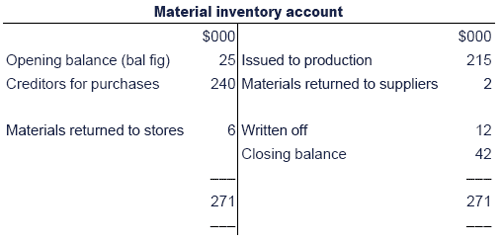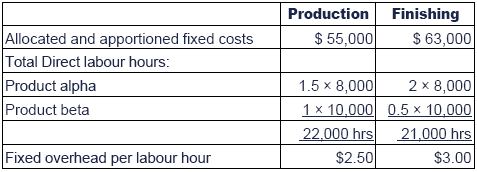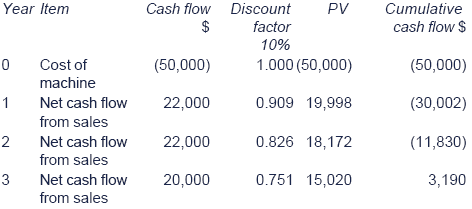Chapter 23: Answers
Chapter 1: The nature and purpose of management accounting
(1) FALSE
Data consists of numbers, letters and raw factsthat have been recorded but not yet processed into a suitable form.Data that has been processed so as to make it meaningful is known asinformation.
(2) B
(3) D
(4) C
(5) C
(6) B
(7) B
Chapter 2: Sources of data
(8) A
Data collection can be simplified by selecting say every 10th or100th unit after the first unit has been chosen randomly as discussedbelow. Such a procedure is called systematic random sampling.
(9) B
(10) C
This method is often applied if the population is particularly large, for example all TV viewers in the UK.
Chapter 4: Types of cost and cost behaviour
(11) B
B is a non-production costs and as such should not be used to value inventory.
(12) D
A Indirect and fixed
B Indirect and fixed
C Direct and variable
D Indirect and variable
(13) B
(14) D
(15) B FALSE
Telephone costs are likely to consist of a fixed element for linerental and a variable element for calls, hence are semi-variable.
(16) C
(17) C
(18) B
Take the highest and lowest output and associated costs.

Hence VC = $4,800/1,200 = $4 per unit.
FC = 3,950 – (800 × 4) = 750 this year and therefore 850 next.
So cost of 1,500 units = 850 + (1500 × 4) = 6850
(19) B
Take the highest and lowest output and associated costs.

Hence VC = $16,000/2,000 = $8 per unit.
FC = 102,000 – (9,000 × 8) = 30,000 at output under 10,000 units.
So cost of 14,000 units = 30,000 + 15,000 + (14,000 × 8) = 157,000
Chapter 5: Ordering and accounting for inventory
(20) The correct answer is C
(21) The correct answer is B

(22) FALSE
The statement refers to periodic stocktaking.
In continuous stocktaking a business counts and values selecteditems of inventory on a rotating basis. Specialist teams count and checkcertain inventory items on each day.
(23) B FALSE
Such waste may be written off but an alternative treatment is toincrease the issue price to production to compensate for the expectedwaste.
(24) A
(25) D
(26) D
(27) A
Closing inventory 110 × $2.20 = $242
(28) B
(29) C
Closing inventory 110 × $2.582 = $284
Chapter 6: Order quantities and reorder levels
(30) B FALSE
The objective of holding buffer inventories is to reduce the riskof a stockout occurring e.g. where supplier lead times are uncertain(the time taken between placing and receiving an order).
The availability of quantity discounts would affect the order quantity not the reorder level.
(31) C – which is a cost of ordering and obtaining the inventory.
(32) C

(33) B

(34) B
ROL = demand in the lead time
Demand per day = 1,000,000 / 250 = 4,000 units.
So expected demand in the lead time and hence ROL is 8,000
C is the EOQ and A the number of orders that would be placed p.a.
Chapter 7: Accounting for labour
(35) B
(36) A TRUE
(37) C
Idle time = 150 hours @ $5 = $750
Overtime (premium only) = 100 × 5 × 4 @ $2.50 = $5000
Total indirect labour element = $5,750
(38) D
Basic rate = 40/60 × $6 = $4
Bonus = 40/60 × $6/60 × 20 = $1.33
Total payment = $5.33
Note: Under Halsey scheme, bonus payment would be:

(39) A

(40) C
Expected hours to produce actual output (standard hours):
600 units × 20/60 = 200 hours
Labour efficiency ratio = 200/220 × 100 = 90.91%
Labour capacity ratio = 220/ 210 × 100 = 104.76%
Production volume ratio = 200/210 × 100 = 95.24%
Chapter 8: Accounting for overheads
(41) B
(42) D
(43) B

Product beta: (1 hr @ $2.5) + (0.5 hrs @ $3) = $4
(44) A
(45) C
(46) C
Pre-determined overhead rate = $504,000/42,000 = $12 per hour
(47) B
(1) Q = 140,000 + 0.3M
(2) M = 113,000 + 0.2Q
Substitute (1) in equation (2):
M = 113,000 + 0.2 (140,000 + 0.3M)
M = 113,000 + 28,000 + 0.06M
0.94M = 141,000
M=150,000
Substituting this into equation (1)
Q = 140,000 + 0.3(150,000) = 185,000
Total overheads for departments

Chapter 9: Marginal and absorption costing
(48) D
(i) Incorrect. Smaller volume products often cause a disproportionate amount of cost.
(ii) Correct
(iii) Incorrect. Marginal costing gives a higher profit.
(iv) Correct
(49) A
(50) B FALSE
The absorption costing approach charges fixed overheads to unitsproduced and as a result achieves a better matching of sales and costsduring a period and a more realistic measure of profit.
(51) C
Closing inventory = 5,000 units
Under full absorption costing a proportion of the fixed manufacturing overhead will be carried forward in this inventory.

This is the difference in annual net income
Chapter 10: Job batch and process costing
(52) C
(53) B
(54) A
Statement (2) is true for job costing but not process costing.
(55) D
Expected output = 90% × 500 = 450 litres
Cost per unit = ($3,000 + $2,670)/450 = $12.60
(56) D

Cost per unit = $12,600/3,600 = $3.50
Abnormal loss = 3,600 – 3,550 = 50kg
Cost of abnormal loss = 50 @ ($3.50 + $2) = $275
(57) B
Physical flow:

Equivalent units calculation:

Cost per EU:

Value of finished output:
Completed units = 45,000 @ ($2.96 + $6.12) = $408,600
Closing WIP:
Material 15,000 @ $2.96 = $44,400
Conversion costs 9,000 @ $6.12 = $55,080
Total closing WIP = $99,480
(58) B
Physical flow:

Value of finished output = value of units start to finish + completed opening WIP:
Units start to finish = 33,000 @ ($3 + $6.25) = $305,250
Completed Opening WIP:

Hence total value of finished production = $305,250 + $101,580 = $406,830
Note: Closing WIP
Material 15,000@$3 = $45,000
Conversion 9000 @ $6.25 = $56,250
Total value = $101,250
(59) C
Chapter 11: Service and operation costing
(69) A TRUE
(61) B – which would use process costing to establish the cost of a physical product
(62) C – which would be of use to the Restaurant/ Kitchen
(63) B FALSE
Many service applications do involve high fixed costs but ahigher number of cost units will result in a lower fixed cost per unit.
(64) B
Total km travelled per vehicle per day = 4 journeys × 25 km (one-way) × 2 = 200km
Total km travelled p.a. = 200km × 5 days x 50 weeks × 6 vehicles = 300,000 km
Total VC = 300,000 km @ $0.50 = $150,000
Total Running costs = $150,000 VC + $225,000 FC = $375,000 p.a.
Total tonne km per vehicle per day = 4 journeys × 25 km × 5 tonnes = 500 tonne km
Total tonne km p.a. = 500 × 5 days × 50 weeks × 6 vehicles = 750,000 km
Standard cost per tonne km = $375,000 / 750,000 = $0.50
Chapter 12: Alternative costing systems
(65) A
ABC is fairly complicated, is a form of absorption (not marginal)costing and is particularly useful when fixed overheads are high andnot primarily volume driven.
(66) D
A customer service team deals with customer queries andcomplaints from outside the organisation, typically after goods havebeen delivered to the customer. The costs of this team arise fromquality failures and are preventable. They are external failure costs.Maintenance is intended to prevent machine breakdowns and so to preventquality failures, and they are therefore prevention costs. Testequipment is used for inspection.
(67) D
A product's life cycle costs are very inclusive; none of these would be excluded.
(68) A
Value analysis involves identify why and how customers value aproduct to enable cost savings to be made without compromising the valueto the customer.
Chapter 13: Forecasting techniques
(69) A
The correlation coefficient measures the strength of theconnection between two variables. A correlation coefficient of 0suggests that the two variables are unrelated and as a result there isno linear relationship between them. The closer the value to +1 or -1the greater the correlation and the more reliable the line of best fit.
(70) C
The calculation of the index for each year is as follows:
20X3 25/22 × 100 = 114
(71) D
(72) D

Difference between Q1 and Q4 budgeted sales = 11,014.7 – 8,075.0 =2,939.7 units
(73) D
Budgeted production each quarter = 38,169/4 = 9,542.25 units
(74) B
X is the time period reference number and for the first quarterof year 1 is 1. The time period reference number for the third quarterof year 7 is 27.
y = 25,000 + 6,500 × 27 = 200,500 units
(75) B FALSE
Using the line to predict values within the range observed is known as interpolation.
(76) C
(77) C
y = (10 × 19) + 150 = 340
Chapter 14: Budgeting
(78) B
(i) Correct
(ii) Correct
(iii) Incorrect, e.g. budget for number of employees required
(iv) Incorrect. Master budget also includes budgeted cash flow
(v) Incorrect. Adjusts variable costs. Fixed are fixed.
(79) C
(80) D
(81) D
Profit = $300,000 x 0.2 = 60,000
Cost of sales = $240,000
Cost of sales = opening inventory + purchases – closing inventory
240,000 = 40,000 + P – 60,000
P = 240,000 – 40,000 + 60,000
P= $260,000
(82) D
Month 4 production = 120,000 + 8,000 – 6,000 = 122,000 units
Month 4 usage = 122,000 units @ 2kg = 244,000 kg
(83) C
Total hours required = 16,000 + 36,000 = 52,000

Chapter 15: Capital Budgeting
(84) B
(85) C
(86) C

2 years and 4 months
Months calculated = 6,000/20,000 × 12 = 3.6 months
(87) D

2 years and 10 months
Months calculated = 11,830/15,020 × 12 = 9.5 months
(88) B

IRR = 15 + [8,800/(8,800 – 225) × 5] =19.9%
(89) C
$100,000/$20,000 = 5 Years
(90) B
IRR = 10 + [12,304/(12,304 – 3,216) × 5] = 13.96% therefore 14%
(91) A

IRR = 10 + [87,980/(87,980 – 32,000) × 10] = 17.3%
(92) B
(93) C
(94) D

IRR = 10 + [48/(48 – 41.24) × 10] = 15.4%
Chapter 16: Behavioural aspects of budgeting
(95) D
Answers A and B refer to profit-related pay and answer C describes either piece work payment or payment by the hour/day.
(96) C
Where there is goal congruence, managers who are working toachieve their own personal goals will automatically also be working toachieve the organisation's goals. Although the use of aspiration levelsto set targets (option D) is likely to help in the achievement of goalcongruence, it is not of itself a definition of the term.
(97) C
Statement (i) is incorrect. Managers at an operational level aremore likely to know what is realistically achievable than a seniormanager imposing budget targets from above. Statement (ii) is arguablycorrect: participation in budgeting could improve motivation. Statement(iii) is correct: imposed budgets should be much quicker to prepare,because less discussion time and negotiation time is required than withparticipative budget-setting.
Chapter 17: Budgetary control
(98) B
Option C is a fixed budget and option D is a rolling budget. Option A is incorrect as a flexible budget includes all costs.
(99) C
A flexible budget helps to control resource efficiency byproviding a realistic budget cost allowance for the actual level ofactivity achieved. Control action can therefore be more effectivebecause the effects of any volume change have been removed from thecomparison.
(100) A
A fixed budget is a budget prepared for a planned single level ofactivity. It does not ignore inflation (option C is incorrect) and itincludes direct costs as well as overhead costs (option D is incorrect).A fixed budget can be prepared for a single product as well as a mix ofproducts (option B is incorrect).
(101) D
The production-line manager does not control prices or rates
Chapter 18: Standard costing
(102) B

(103) C
(104) C
(105) A
$105,000 – 30,000 × $3.30 = $6,000 adverse
(106) C
Budget selling price = $108,000/9,000 = $12
$104,500 – 9,500 × $12 = $9,500 adverse
(107) B
Standard contribution = $36,000/9,000 = $4 per unit
Volume variance = 500 × $4 = $2,000 favourable.
(108) B

Therefore actual rate per hour = $56,576/8,320 = $6.80
(109) B FALSE
The fixed overhead volume variance can be subdivided into a capacity and an efficiency variance.
(110) D
Standard fixed overhead rate per unit = $280,000 / 7,000 = $40 per unit
Fixed overhead volume variance = 200 units × $40 = $8,000 favourable (over-absorbed)
(111) B
Chapter 19: Performance measurement techniques
(112) C
RI = Net profit before interest – (10% × invested capital)
Therefore £240,000 = £640,000 – (10% × invested capital)
So 10% × invested capital = £400,000
Therefore invested capital = £4m
ROI = Net profit before interest/Invested capital
ROI = £640,000/£4,000,000 × 100 = 16%
(113) B
Output per standard hour is 2 units as each unit has a standard time allowance of 30 minutes.
Budgeted labour hours are 1,500/2 = 750
The actual output measured in standard hours is 1,400/2 = 700 standard hours
The PV ratio = 700/750 x 100% = 93.3%
(114) C
The capacity ratio = 720/750 x 100% = 96%
(115) A
The efficiency ratio = 700/720 x 100% = 97.2%
(116) D
(117) B
The current ratio is all current assets including inventorydivided by current liabilities, while the acid test is the current assetfigure less inventory divided by current liabilities. These can only beequal if a firm carries no inventory.
Chapter 20: Performance measurement in specific situations
(118) B
Reducing mortality rates is likely to be a stated objective of the hospital and as such is a measure of output, or effectiveness
(119) B
The manager of a profit centre can exercise control over revenuesand controllable costs, but has no influence concerning the capitalinvested in the centre.
Contribution (i) would be a useful performance measure because aprofit centre manager can exercise control over sales revenue andvariable costs. Controllable profit (ii) would also be useful as long asany overhead costs charged in deriving the profit figure arecontrollable by the profit centre manager. Apportioned central costswould not be deducted when calculating controllable profit. Return oninvestment (iii), residual income (iv) would not be useful because theyrequire a measure of the capital invested in the division.
Chapter 21: Spreadsheets
(120) A TRUE
(121) B FALSE
A database would be more useful.
Spread sheets are designed to analyse data and sort list items, not for long-term storage of raw data.
(122) C
Spreadsheet packages do include a graphical function.
(123) B
Where a database would be more suitable.
|
Created at 5/24/2012 5:28 PM by System Account
(GMT) Greenwich Mean Time : Dublin, Edinburgh, Lisbon, London
|
Last modified at 5/25/2012 12:53 PM by System Account
(GMT) Greenwich Mean Time : Dublin, Edinburgh, Lisbon, London
|
|
|
|
 |
Rating
:
|
 Ratings & Comments
(Click the stars to rate the page) Ratings & Comments
(Click the stars to rate the page)
|
 |
Tags:
|
|
|
|
|